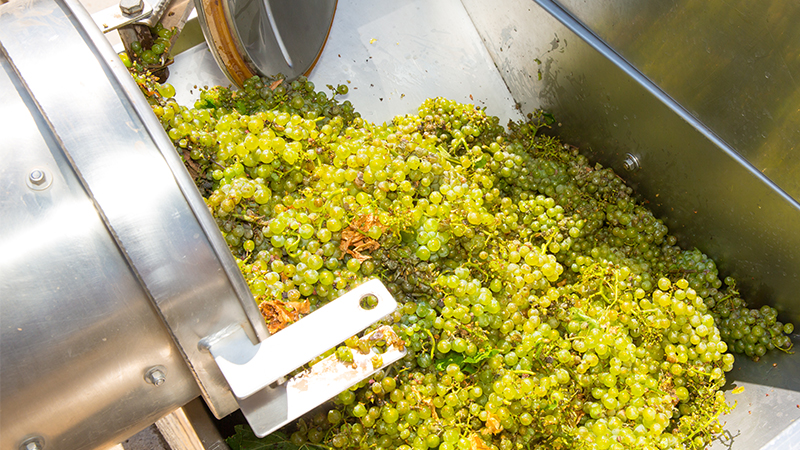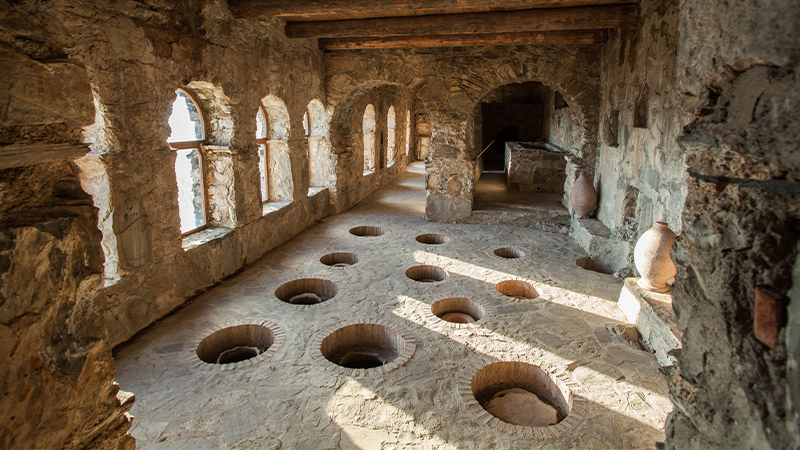Unless you’ve been living under a rock, you’ve no doubt felt the orange wine crush. For the past few years, they’ve become the darling of the wine-professional circuit, creeping onto wine menus.
Not quite white wine, not quite red, and somewhat akin to rosé, orange wine sits within its own category. And while many have been open to tasting orange wine, not everyone may know exactly what it is. In short, it’s all about the skins. But, if you’re curious to know more, we’ve got a handy primer for you.
How Orange Wine Is Made
The simplest explanation is that orange wine is made from white grapes using the same process used to make red wine. Traditionally, white wines are made from white grapes pressed immediately after harvest to remove the juice from the grape cluster’s skins, seeds, and stems. This yields a clear liquid to ferment into white wine. With red wine, the process is almost the opposite. The red skins of the grapes give red wine its color. (In fact, with a few exceptions, most red grapes have clear juice, just like white grapes.) The grapes are left to macerate with the skin and juice to extract color during fermentation.
Don’t Miss A Drop
Get the latest in beer, wine, and cocktail culture sent straight to your inbox.
Color isn’t the only thing afforded to red wines when left in contact with the skins. The skins, seeds, and stems all impart texture from tannins and complexity from other phenolic compounds that affect how the finished wine tastes and feels.
The concept of orange wine is rooted in imparting the same structural characteristics to white wine as in red wine. To achieve this, white grape juice is left in contact with the skins during fermentation. This can last anywhere from a few days to a couple of years, depending on where it is produced. The result is a white wine with a bit more structure and complexity.

So why is it called orange wine? Contrary to what the name might infer, there aren’t actually any oranges involved in the winemaking process. The name comes instead from the slightly orange, amber, rosy color the wine takes on.
Though some white grapes, such as Pinot Gris and Gewürztraminer, have skins with a light rosy hue that contributes color to the wines, the orange-amber tone is partly the result of the increased exposure to oxygen the juice experiences during the skin maceration process. It’s the same principle as a sliced apple that begins to brown after sitting in the air for a while. Though the air exposure is generally minimal, it’s enough for the wine to take on a little bit of color. Temperature also plays a key role. The warmer the fermentation, the deeper the color of the wine.
The History of Orange Wine
Though orange wine has seen an epic rise in popularity in recent years, there’s nothing new about this style of wine. Its origins are ancient — as in, it’s been produced for millennia. Archeological evidence shows that it was made as far back as 6000 B.C. in what is now the modern-day country of Georgia. Here, wines were made predominantly from the Rkatsiteli grape in clay vessels buried in the ground to keep temperatures lower. These vessels, known as qvevri, are traditionally lined and sealed with beeswax and stone lids. This tradition still defines much of Georgian winemaking today.

Orange Wine Worldwide
But other forms were found during the Roman empire. The Romans used clay pots, or amphorae, to transport wine to regions such as Alentejo, Portugal, where the practice remains a central part of the winemaking tradition. Though much of the amphora or ”tahla” wine is red, many producers, such as Herdade do Rocim and Adega Cartuxa, also make a version of white, skin-contact wine.
In northeastern Italy, ”ramato,” which is Italian for auburn or copper, is a style of orange wine primarily made from Pinot Grigio, as well as Sauvignon Vert, and Ribolla Gialla. In the neighboring Slovenia, the style has become a hallmark of the country’s historic winemaking tradition. In France, the Jura region is known for Vin Jaune and Côtes du Jura, both of which are made in a similar method with an oxidative style. In the New World, particularly within the last decade, producers in New York, California, Oregon, Australia, Chile, and more have experimented with the style.
What Does Orange Wine Taste Like?
Because orange wine is made using a wide range of grape varieties and at different temperatures in different climates, the diversity within this style is vast. This diversity makes it hard to describe the category in specific terms. But generally speaking, orange wines can be floral or citrusy, with ripe stone fruit or herbaceous notes. The common thread tends to be oxidative characteristics of nuttiness, honey, bruised apple, and dried citrus rind. These wines can be tart and sometimes show a sour-beer quality.
The Best Food Pairings for Orange Wine
Orange wines are typically dry with hints of tannin and a weightier mouthfeel. More robust than white wine but with less intensity than bold, tannic reds, this style is a perfect match for a variety of cuisines. Bold flavors work best — try strong cheeses, charcuterie, or Moroccan dishes with cumin, pepper, cinnamon, paprika, and saffron spices. Indian curries, savory Spanish-style tapas, and grilled meats and fish also pair nicely.


